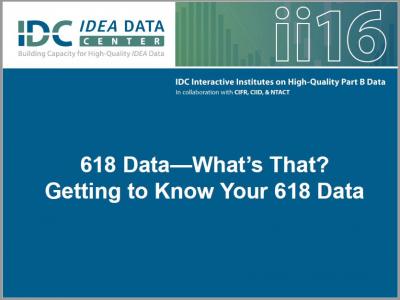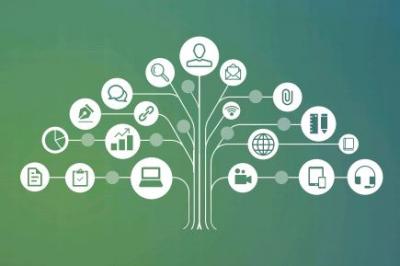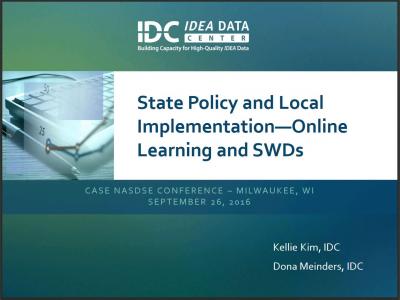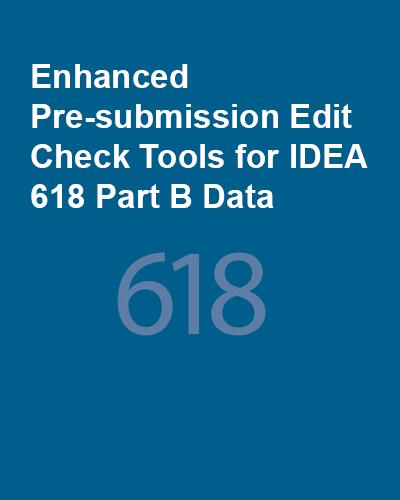Site Search
Results 15 - 20 of 20
Format: Presentations
618 Data—What’s That? Getting to Know Your 618 DataHave you heard these terms 618, 616, EDFacts, EMAPS, file specifications, OMB-MAX, GRADS360, Data Quality Reports? Do you understand what they are referencing? Do you want to gain a higher knowledge of these terms? Participants in this presentation learned more about IDEA data reporting requirements in relation to the 618 data collections. They also learned about data quality considerations and tools states can use when going through the data collecting and reporting procedures.
Format: Toolkits
SEA Data Processes ToolkitUsing the SEA Data Processes Toolkit to document data processes for all 616 and 618 data collections will establish a well-managed process for data collection, validation, and submission. In collaboration with IDC State Liaisons, states can use the toolkit to create and maintain a culture of high-quality data and establish and support consistent practices that produce valid and reliable data, while building the capacity of state staff.
Format: Toolkits and Templates
Part C IDEA Data Processes ToolkitUsing the Part C IDEA Data Processes Toolkit to document data processes for all 616 and 618 data collections will establish a well-managed process for data collection, validation, and submission. In collaboration with IDC State Liaisons, states can use the toolkit to create and maintain a culture of high-quality data and establish and support consistent practices that produce valid and reliable data, while building the capacity of state staff. The toolkit contains an overview of the toolkit, Data Collection Protocols, SPP/APR Indicator Protocols, a State Landscape Protocol, a Local EI Program Determinations Protocol, a Data Collections Calendar, and additional resources that provide a structure for documenting data processes. The Data Collection Protocols are in Word, and states can tailor them meet their states' specific documentation needs.
Format: Presentations
State Policy and Local Implementation—Online Learning and SWDsFindings from IDC’s white paper and interviews of select states revealed that LEAs are responsible for determining LRE and implementation and monitoring of IEPs in online environments. Presentation of findings were followed by a panel discussion of states and LEAs to discuss key problems of practice and needs for resources that IDC can develop to support greater understanding of implications of online learning for SWDs and the relationship to high-quality data.
Format: Guides, Papers, and Reports
Examining Part C Exiting Data VariationUsing national averages for each of the exiting categories, this white paper helps state personnel examine differences in their Part C Exiting data. The paper explores Part C Exiting data category definitions, as well as general and specific trends in Part C Exiting data. It also includes suggestions for possible strategies to improve data quality, including clarifying policies and definitions, documenting procedures for implementation of policies, and developing training materials related to reporting exiting data.
Format: Applications and Spreadsheets
SEA Edit Check and Data Display Tools for IDEA 618 Part B DataIDC presents the SEA Edit Check and Data Display Tools for IDEA 618 Part B Data to help states prepare their Part B data submissions. States can use these tools to review the contents of their IDEA 618 EDFacts Part B personnel, exiting, discipline and child count and educational environment data for children ages 3–5 (FS089) and students ages 6–21 (FS002) prior to submission to the EDFacts Submission System or ESS. The tools apply edit checks and identify potential errors in subtotals or totals in the data files. In addition, the tools provide user-friendly summaries of the 618 data. The tools are enhanced versions of the SEA Edit Check and Data Display Tools for personnel, exiting, discipline, and child count and educational environment data. The main difference is the enhanced edit check tools require states to directly copy and paste the EDFacts data files they will submit to ESS as opposed to manually entering data into an Excel file in a format that is different than the one required for submission to ESS.







